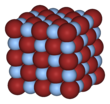| |||
| Names | |||
|---|---|---|---|
| Other names | |||
| Identifiers | |||
3D model (JSmol)
|
|||
| ChemSpider | |||
| ECHA InfoCard | 100.029.160 | ||
| UNII | |||
CompTox Dashboard (EPA)
|
|||
| |||
| |||
| Properties | |||
| AgBr | |||
| Molar mass | 187.77 g/mol | ||
| Appearance | Pale yellow solid photosensitive | ||
| Density | 6.473 g/cm3, solid | ||
| Melting point | 432 °C (810 °F; 705 K) | ||
| Boiling point | 1,502 °C (2,736 °F; 1,775 K) (decomposes) | ||
| 0.140 mg/L (20 °C) | |||
Solubility product (Ksp)
|
5.4 × 10 −13 | ||
| Solubility | insoluble in alcohol, most acids sparingly soluble in ammonia soluble in alkali cyanide solutions | ||
| Band gap | 2.5 eV | ||
| Electron mobility | 4000 cm2/(V·s) | ||
| −59.7·10−6 cm3/mol | |||
Refractive index (nD)
|
2.253 | ||
| Thermochemistry | |||
Heat capacity (C)
|
270 J/(kg·K) | ||
Std molar
entropy (S⦵298) |
107 J·mol−1·K−1[1] | ||
Std enthalpy of
formation (ΔfH⦵298) |
−100 kJ·mol−1[1] | ||
| Hazards | |||
| NFPA 704 (fire diamond) | |||
| Related compounds | |||
Other anions
|
Silver(I) fluoride Silver chloride Silver iodide | ||
Other cations
|
Copper(I) bromide Mercury(I) bromide | ||
Except where otherwise noted, data are given for materials in their standard state (at 25 °C [77 °F], 100 kPa).
| |||
Silver bromide (AgBr), a soft, pale-yellow, water-insoluble salt well known (along with other silver halides) for its unusual sensitivity to light. This property has allowed silver halides to become the basis of modern photographic materials.[2] AgBr is widely used in photographic films and is believed by some to have been used for making the Shroud of Turin.[3] The salt can be found naturally as the mineral bromargyrite (bromyrite).
- ^ a b Zumdahl, Steven S. (2009). Chemical Principles 6th Ed. Houghton Mifflin Company. p. A23. ISBN 978-0-618-94690-7.
- ^ Greenwood, N.N., Earnshaw, A. (1984). Chemistry of the Elements. New York: Permagon Press. pp. 1185–87. ISBN 978-0-08-022057-4.
{{cite book}}: CS1 maint: multiple names: authors list (link) - ^ Hamilton, J.F. (1974). "Physical Properties of Silver Halide Microcrystals". Photographic Science and Engineering. 18 (5): 493–500.


